Yuetong Fang
Adaptive Scaling of Policy Constraints for Offline Reinforcement Learning
Aug 27, 2025Abstract:Offline reinforcement learning (RL) enables learning effective policies from fixed datasets without any environment interaction. Existing methods typically employ policy constraints to mitigate the distribution shift encountered during offline RL training. However, because the scale of the constraints varies across tasks and datasets of differing quality, existing methods must meticulously tune hyperparameters to match each dataset, which is time-consuming and often impractical. We propose Adaptive Scaling of Policy Constraints (ASPC), a second-order differentiable framework that dynamically balances RL and behavior cloning (BC) during training. We theoretically analyze its performance improvement guarantee. In experiments on 39 datasets across four D4RL domains, ASPC using a single hyperparameter configuration outperforms other adaptive constraint methods and state-of-the-art offline RL algorithms that require per-dataset tuning while incurring only minimal computational overhead. The code will be released at https://github.com/Colin-Jing/ASPC.
Hierarchical Multi-Label Contrastive Learning for Protein-Protein Interaction Prediction Across Organisms
Jul 03, 2025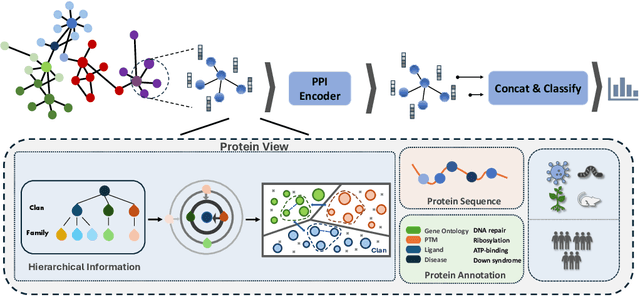
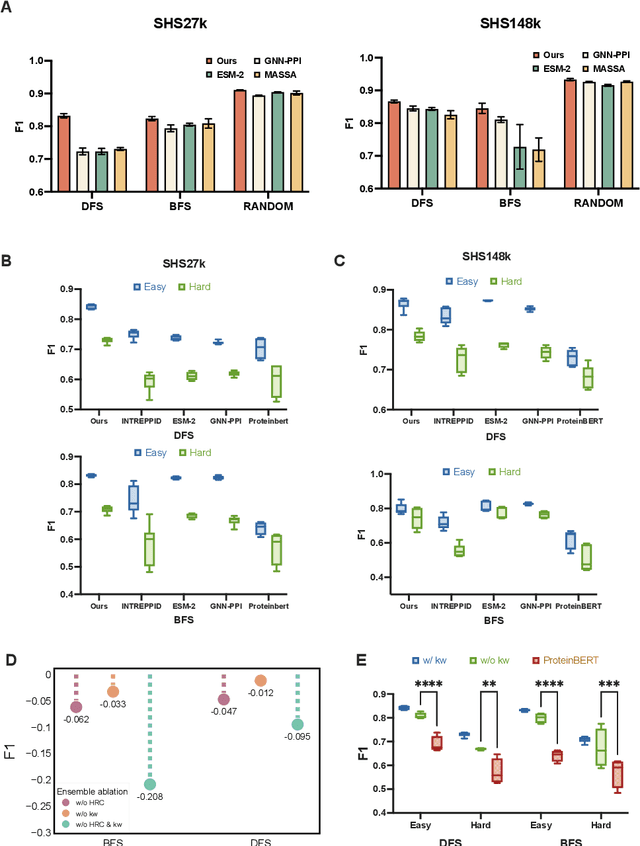
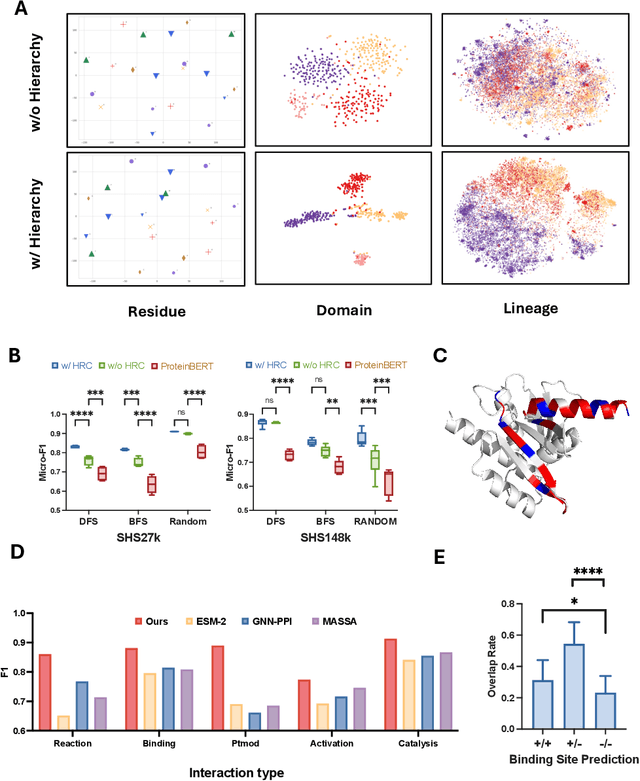
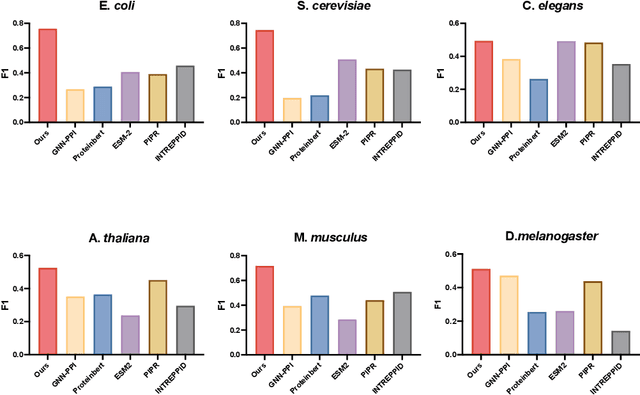
Abstract:Recent advances in AI for science have highlighted the power of contrastive learning in bridging heterogeneous biological data modalities. Building on this paradigm, we propose HIPPO (HIerarchical Protein-Protein interaction prediction across Organisms), a hierarchical contrastive framework for protein-protein interaction(PPI) prediction, where protein sequences and their hierarchical attributes are aligned through multi-tiered biological representation matching. The proposed approach incorporates hierarchical contrastive loss functions that emulate the structured relationship among functional classes of proteins. The framework adaptively incorporates domain and family knowledge through a data-driven penalty mechanism, enforcing consistency between the learned embedding space and the intrinsic hierarchy of protein functions. Experiments on benchmark datasets demonstrate that HIPPO achieves state-of-the-art performance, outperforming existing methods and showing robustness in low-data regimes. Notably, the model demonstrates strong zero-shot transferability to other species without retraining, enabling reliable PPI prediction and functional inference even in less characterized or rare organisms where experimental data are limited. Further analysis reveals that hierarchical feature fusion is critical for capturing conserved interaction determinants, such as binding motifs and functional annotations. This work advances cross-species PPI prediction and provides a unified framework for interaction prediction in scenarios with sparse or imbalanced multi-species data.
Spiking Transformers Need High Frequency Information
May 24, 2025Abstract:Spiking Transformers offer an energy-efficient alternative to conventional deep learning by transmitting information solely through binary (0/1) spikes. However, there remains a substantial performance gap compared to artificial neural networks. A common belief is that their binary and sparse activation transmission leads to information loss, thus degrading feature representation and accuracy. In this work, however, we reveal for the first time that spiking neurons preferentially propagate low-frequency information. We hypothesize that the rapid dissipation of high-frequency components is the primary cause of performance degradation. For example, on Cifar-100, adopting Avg-Pooling (low-pass) for token mixing lowers performance to 76.73%; interestingly, replacing it with Max-Pooling (high-pass) pushes the top-1 accuracy to 79.12%, surpassing the well-tuned Spikformer baseline by 0.97%. Accordingly, we introduce Max-Former that restores high-frequency signals through two frequency-enhancing operators: extra Max-Pooling in patch embedding and Depth-Wise Convolution in place of self-attention. Notably, our Max-Former (63.99 M) hits the top-1 accuracy of 82.39% on ImageNet, showing a +7.58% improvement over Spikformer with comparable model size (74.81%, 66.34 M). We hope this simple yet effective solution inspires future research to explore the distinctive nature of spiking neural networks, beyond the established practice in standard deep learning.
CoRe^2: Collect, Reflect and Refine to Generate Better and Faster
Mar 12, 2025Abstract:Making text-to-image (T2I) generative model sample both fast and well represents a promising research direction. Previous studies have typically focused on either enhancing the visual quality of synthesized images at the expense of sampling efficiency or dramatically accelerating sampling without improving the base model's generative capacity. Moreover, nearly all inference methods have not been able to ensure stable performance simultaneously on both diffusion models (DMs) and visual autoregressive models (ARMs). In this paper, we introduce a novel plug-and-play inference paradigm, CoRe^2, which comprises three subprocesses: Collect, Reflect, and Refine. CoRe^2 first collects classifier-free guidance (CFG) trajectories, and then use collected data to train a weak model that reflects the easy-to-learn contents while reducing number of function evaluations during inference by half. Subsequently, CoRe^2 employs weak-to-strong guidance to refine the conditional output, thereby improving the model's capacity to generate high-frequency and realistic content, which is difficult for the base model to capture. To the best of our knowledge, CoRe^2 is the first to demonstrate both efficiency and effectiveness across a wide range of DMs, including SDXL, SD3.5, and FLUX, as well as ARMs like LlamaGen. It has exhibited significant performance improvements on HPD v2, Pick-of-Pic, Drawbench, GenEval, and T2I-Compbench. Furthermore, CoRe^2 can be seamlessly integrated with the state-of-the-art Z-Sampling, outperforming it by 0.3 and 0.16 on PickScore and AES, while achieving 5.64s time saving using SD3.5.Code is released at https://github.com/xie-lab-ml/CoRe/tree/main.
Optimal Brain Apoptosis
Feb 25, 2025

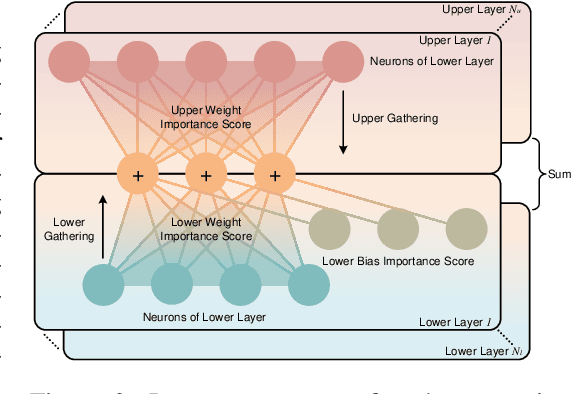
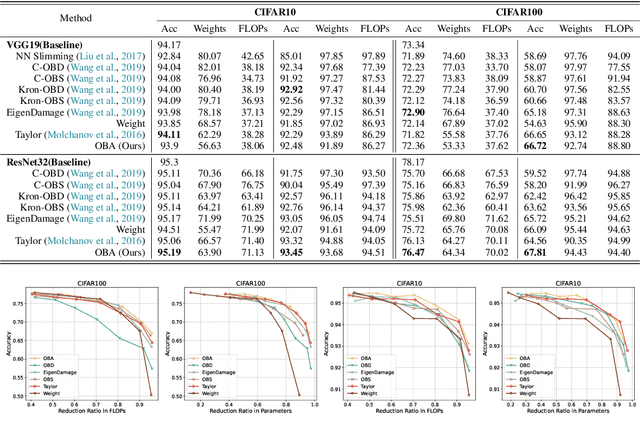
Abstract:The increasing complexity and parameter count of Convolutional Neural Networks (CNNs) and Transformers pose challenges in terms of computational efficiency and resource demands. Pruning has been identified as an effective strategy to address these challenges by removing redundant elements such as neurons, channels, or connections, thereby enhancing computational efficiency without heavily compromising performance. This paper builds on the foundational work of Optimal Brain Damage (OBD) by advancing the methodology of parameter importance estimation using the Hessian matrix. Unlike previous approaches that rely on approximations, we introduce Optimal Brain Apoptosis (OBA), a novel pruning method that calculates the Hessian-vector product value directly for each parameter. By decomposing the Hessian matrix across network layers and identifying conditions under which inter-layer Hessian submatrices are non-zero, we propose a highly efficient technique for computing the second-order Taylor expansion of parameters. This approach allows for a more precise pruning process, particularly in the context of CNNs and Transformers, as validated in our experiments including VGG19, ResNet32, ResNet50, and ViT-B/16 on CIFAR10, CIFAR100 and Imagenet datasets. Our code is available at https://github.com/NEU-REAL/OBA.
Frequency-aware Event Cloud Network
Dec 30, 2024



Abstract:Event cameras are biologically inspired sensors that emit events asynchronously with remarkable temporal resolution, garnering significant attention from both industry and academia. Mainstream methods favor frame and voxel representations, which reach a satisfactory performance while introducing time-consuming transformation, bulky models, and sacrificing fine-grained temporal information. Alternatively, Point Cloud representation demonstrates promise in addressing the mentioned weaknesses, but it ignores the polarity information, and its models have limited proficiency in abstracting long-term events' features. In this paper, we propose a frequency-aware network named FECNet that leverages Event Cloud representations. FECNet fully utilizes 2S-1T-1P Event Cloud by innovating the event-based Group and Sampling module. To accommodate the long sequence events from Event Cloud, FECNet embraces feature extraction in the frequency domain via the Fourier transform. This approach substantially extinguishes the explosion of Multiply Accumulate Operations (MACs) while effectively abstracting spatial-temporal features. We conducted extensive experiments on event-based object classification, action recognition, and human pose estimation tasks, and the results substantiate the effectiveness and efficiency of FECNet.
Adaptive Calibration: A Unified Conversion Framework of Spiking Neural Network
Dec 18, 2024Abstract:Spiking Neural Networks (SNNs) are seen as an energy-efficient alternative to traditional Artificial Neural Networks (ANNs), but the performance gap remains a challenge. While this gap is narrowing through ANN-to-SNN conversion, substantial computational resources are still needed, and the energy efficiency of converted SNNs cannot be ensured. To address this, we present a unified training-free conversion framework that significantly enhances both the performance and efficiency of converted SNNs. Inspired by the biological nervous system, we propose a novel Adaptive-Firing Neuron Model (AdaFire), which dynamically adjusts firing patterns across different layers to substantially reduce the Unevenness Error - the primary source of error of converted SNNs within limited inference timesteps. We further introduce two efficiency-enhancing techniques: the Sensitivity Spike Compression (SSC) technique for reducing spike operations, and the Input-aware Adaptive Timesteps (IAT) technique for decreasing latency. These methods collectively enable our approach to achieve state-of-the-art performance while delivering significant energy savings of up to 70.1%, 60.3%, and 43.1% on CIFAR-10, CIFAR-100, and ImageNet datasets, respectively. Extensive experiments across 2D, 3D, event-driven classification tasks, object detection, and segmentation tasks, demonstrate the effectiveness of our method in various domains. The code is available at: https://github.com/bic-L/burst-ann2snn.
Rethinking Efficient and Effective Point-based Networks for Event Camera Classification and Regression: EventMamba
May 09, 2024Abstract:Event cameras, drawing inspiration from biological systems, efficiently detect changes in ambient light with low latency and high dynamic range while consuming minimal power. The most current approach to processing event data often involves converting it into frame-based representations, which is well-established in traditional vision. However, this approach neglects the sparsity of event data, loses fine-grained temporal information during the transformation process, and increases the computational burden, making it ineffective for characterizing event camera properties. In contrast, Point Cloud is a popular representation for 3D processing and is better suited to match the sparse and asynchronous nature of the event camera. Nevertheless, despite the theoretical compatibility of point-based methods with event cameras, the results show a performance gap that is not yet satisfactory compared to frame-based methods. In order to bridge the performance gap, we propose EventMamba, an efficient and effective Point Cloud framework that achieves competitive results even compared to the state-of-the-art (SOTA) frame-based method in both classification and regression tasks. This notable accomplishment is facilitated by our rethinking of the distinction between Event Cloud and Point Cloud, emphasizing effective temporal information extraction through optimized network structures. Specifically, EventMamba leverages temporal aggregation and State Space Model (SSM) based Mamba boasting enhanced temporal information extraction capabilities. Through a hierarchical structure, EventMamba is adept at abstracting local and global spatial features and implicit and explicit temporal features. By adhering to the lightweight design principle, EventMamba delivers impressive results with minimal computational resource utilization, demonstrating its efficiency and effectiveness.
Spiking Wavelet Transformer
Mar 26, 2024



Abstract:Spiking neural networks (SNNs) offer an energy-efficient alternative to conventional deep learning by mimicking the event-driven processing of the brain. Incorporating the Transformers with SNNs has shown promise for accuracy, yet it is incompetent to capture high-frequency patterns like moving edge and pixel-level brightness changes due to their reliance on global self-attention operations. Porting frequency representations in SNN is challenging yet crucial for event-driven vision. To address this issue, we propose the Spiking Wavelet Transformer (SWformer), an attention-free architecture that effectively learns comprehensive spatial-frequency features in a spike-driven manner by leveraging the sparse wavelet transform. The critical component is a Frequency-Aware Token Mixer (FATM) with three branches: 1) spiking wavelet learner for spatial-frequency domain learning, 2) convolution-based learner for spatial feature extraction, and 3) spiking pointwise convolution for cross-channel information aggregation. We also adopt negative spike dynamics to strengthen the frequency representation further. This enables the SWformer to outperform vanilla Spiking Transformers in capturing high-frequency visual components, as evidenced by our empirical results. Experiments on both static and neuromorphic datasets demonstrate SWformer's effectiveness in capturing spatial-frequency patterns in a multiplication-free, event-driven fashion, outperforming state-of-the-art SNNs. SWformer achieves an over 50% reduction in energy consumption, a 21.1% reduction in parameter count, and a 2.40% performance improvement on the ImageNet dataset compared to vanilla Spiking Transformers.
Bursting Spikes: Efficient and High-performance SNNs for Event-based Vision
Nov 24, 2023



Abstract:Advancing event-driven vision through spiking neural networks (SNNs) is crucial to empowering high-speed and efficient perception. While directly converting the pre-trained artificial neural networks (ANNs) - by replacing the non-linear activation with spiking neurons - can provide SNNs with good performance, the resultant SNNs typically demand long timesteps and high energy consumption to achieve their optimal performance. To address this challenge, we introduce the burst-spike mechanism inspired by the biological nervous system, allowing multiple spikes per timestep to reduce conversion errors and produce low-latency SNNs. To further bolster this enhancement, we leverage the Pareto Frontier-driven algorithm to reallocate burst-firing patterns. Moreover, to reduce energy consumption during the conversion process, we propose a sensitivity-driven spike compression technique, which automatically locates the optimal threshold ratio according to layer-specific sensitivity. Extensive experiments demonstrate our approach outperforms state-of-the-art SNN methods, showcasing superior performance and reduced energy usage across classification and object detection. Our code will be available at https://github.com/bic-L/burst-ann2snn.
 Add to Chrome
Add to Chrome Add to Firefox
Add to Firefox Add to Edge
Add to Edge